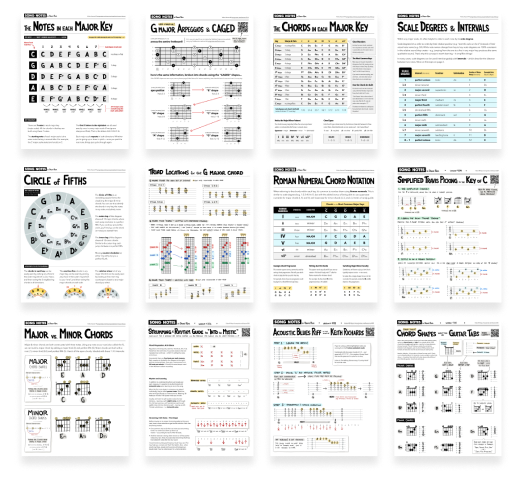Open chords in the Key of E
Lesson #202 • Dec 26, 2018
Video Overview
Instructional PDF 2 pages
Editor’s notes
One of my favorite things to dive into when I pick up my guitar is freely strumming open chords in the key of E. By which I mean, taking the traditional chord voicings in the key of E-major (E F#m G#m A B C#m) and playing these shapes with the 1st, 2nd, and 6th strings left open. Using these open chord voicings as building blocks, you can combine then any way you want - and end up with some progressions that sound easy, breezy, and downright fun to play. Which is what makes for a good low-stress warm up exercise! Let me show you how it’s done.
The typical way to play chords in the key of E
First, let’s understand how to “normally” play these chords in the key of E-major. Going up the fretboard we have:
e –––0––––2––––4––––5––––7––––9––– –––––
B –––0––––2––––4––––5––––7––––9––– ––9––
G –––1––––2––––4––––6––––8––––9––– ––9––
D –––2––––4––––6––––7––––9–––11––– ––9––
A –––2––––4––––6––––7––––9–––11––– ––7––
E –––0––––2––––4––––5––––7––––9––– ––0––
E F#m G#m A B C#m E
Those same chords, but with open voicings
Here, we’re going to make the sweeping change (for all of the chords) of leaving the 1st, 2nd, and 6th strings open. Meaning, we’re not going to press down frets on those strings - no matter what the chord is.
e –––0––––0––––0––––0––––0––––0––– ––0––
B –––0––––0––––0––––0––––0––––0––– ––0––
G –––1––––2––––4––––6––––8––––9––– ––9––
D –––2––––4––––6––––7––––9–––11––– ––9––
A –––2––––4––––6––––7––––9–––11––– ––7––
E –––0––––0––––0––––0––––0––––0––– ––0––
E F#m G#m A B C#m E
Here are those same shapes (in tab form), without the 1st 2nd or 6 strings typed out. You should still play those 3 strings (leave them open) - but the focus here is to notice the chord shapes you’re using. Look for patterns. For example, the E A and B chords all use the same shape on the 3rd, 4th, and 5th strings. Likewise, the F#m G#m and C#m all use the same shape.
e –––––––––––––––––––––––––––––––– –––––
B –––––––––––––––––––––––––––––––– –––––
G –––1––––2––––4––––6––––8––––9––– ––9––
D –––2––––4––––6––––7––––9–––11––– ––9––
A –––2––––4––––6––––7––––9–––11––– ––7––
E –––––––––––––––––––––––––––––––– –––––
E F#m G#m A B C#m E
Now, mix and match these chord shapes!
Think of each of these chord shapes as a building block - which can be freely used & combined in any order. Keep this in mind when playing these shapes. Try out a few of them together, in a pattern, and repeat. Experiment with different strumming patterns. Play around with which strings you’re accenting. Mix it up! Especially when you’re warming up, this sort of free play can be very helpful to get the blood flowing and try something new.
Why do some of these chords sound weird?
You’ll notice that some of these chords sound “better” than others. Specifically, the E-major shape sounds the best - while the G#m sounds dissonant (and clashing to the ear). The A and the B have a major sound, but don’t ring as cleanly as “normal” A and B chords. This is all okay! The reason is that, those open strings (the 1st, 2nd, and 6th strings) are notes that aren’t used in many of these chords - which makes them sound a bit “off” and less defined. But, I think this is fine - music isn’t always about coloring inside the lines. And while some of these chords sound cleaner than others, they’re all using notes from the key of E - so there is a nice consistency that can be heard no matter how you put them together.
Good luck!
I hope this was helpful. As always, I encourage you to be in touch with any questions.
Enjoy my lessons? Buy me a beer!
If this and my other lessons have proven helpful to you, please consider making a one-time donation to my tip jar. Contributions of any amount help make this project possible (including the many, many hours I put into it).
Fun & Helpful Tools I've Made
Subscribe to my YouTube channel
Be sure to never miss a lesson by subscribing on YouTube. I put out 2-3 new videos every week. These include full song lessons, as well as covers, practice tips, behind-the-scenes updates. Thanks!
Recent Lessons
-
April 18, 2024
"Moonshadow" by Cat Stevens
-
April 9, 2024
Chords & Music Theory... 9 New Lessons!
-
March 30, 2024
Gordon Lightfoot's "Carefree Highway"
-
March 22, 2024
Lead Guitar & the F1 Theme Song
-
March 15, 2023
Pink Floyd's "Breathe" - with Simpler Chords Included
-
March 6, 2024
Q&A: 8 Tips to Avoid Muting Strings
-
March 1, 2024
Blues Shuffle Riffs - Using Just 2 Strings!
-
February 16, 2024
Soulful Lead Guitar with "America the Beautiful"
-
February 8, 2024
Country Honk by The Rolling Stones
-
January 31, 2024
Beginner Blues - New Course Sneak Peek!


